
Have you ever watched a hummingbird in flight and wondered about the secrets of its energetic life? These tiny birds, often no bigger than your thumb, are true wonders of nature.
Today, we’re diving into the vibrant world of hummingbirds with some fun facts. From their incredible flying abilities to their vivid colors, prepare to be amazed by what these little creatures can do!
The hummingbird competes with the stillness of the air.
Chogyam Trungpa
Hummingbird Facts
Welcome to our journey through the lives of hummingbirds! Read carefully, as you will need to remember these facts for the quiz at the end to prove your mastery.
- These birds can rotate their wings in a full circle.
- They are the only bird species that can fly backwards.
- With hearts making up 2.5% of their body weight, their heart rate can exceed 1200 beats per minute when active.
- Their metabolism is so intense that they consume more than their own weight in nectar each day.
- They can hover by flapping their wings in a figure-eight pattern, a feat unique among birds.
- These creatures require enormous amounts of sleep, roughly 12-14 hours each night.
- They are capable of fasting overnight, slowing their metabolism to survive without food.
- To conserve energy, they can enter a state known as torpor which is similar to hibernation.
- Despite their small size, they can travel up to 500 miles nonstop over the Gulf of Mexico during migration.
- Their tongues have tubes that work like a pump to draw nectar.
- Each bird has a unique bill shape tailored to the specific flowers it feeds from.
- They can perceive colors beyond the human visual spectrum, including ultraviolet light.
- These birds are highly territorial; they often attack other birds to protect their feeding areas.


